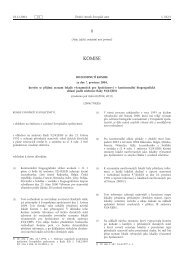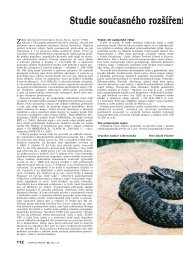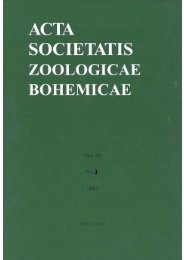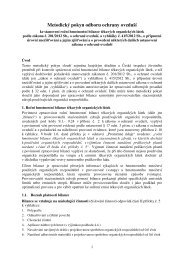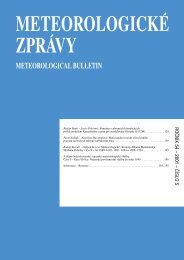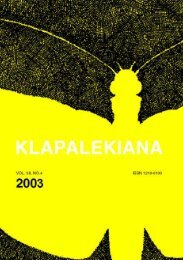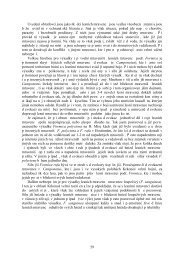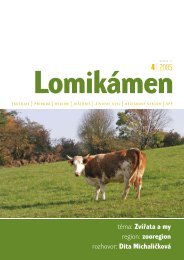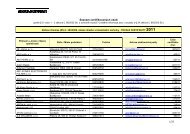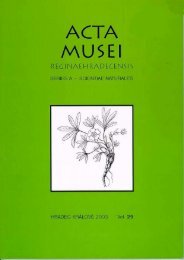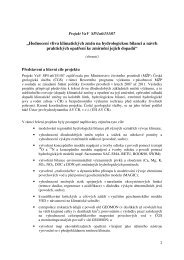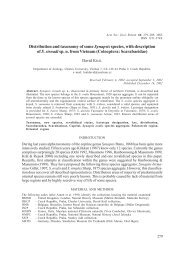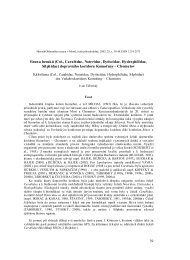journal of forest science
journal of forest science
journal of forest science
You also want an ePaper? Increase the reach of your titles
YUMPU automatically turns print PDFs into web optimized ePapers that Google loves.
1989 – deionised water; MCKAY 1998 – distilled water;<br />
SMIT-SPINKS et al. 1985 – solution <strong>of</strong> CaSO 4 ). Moreover<br />
there were different ways <strong>of</strong> autoclaving and measurement.<br />
The objective <strong>of</strong> this study was to find the influence <strong>of</strong><br />
different duration <strong>of</strong> autoclaving on the rate <strong>of</strong> electrolyte<br />
leakage from oak tap root and changes <strong>of</strong> EL rate<br />
measured in different time intervals after stress treatments.<br />
Specific aim was to test changes <strong>of</strong> electrolyte<br />
leakage rate from tap root after same intensive stress factors<br />
on different dates.<br />
MATERIALS AND METHODS<br />
Two-years old bare-rooted seedlings <strong>of</strong> pendunculate<br />
oak (Quercus robur L.) which had been growing in<br />
a nursery <strong>of</strong> Lower Saxon orestry Institute (360 m a.s.l.,<br />
annual precipitation 800 mm, in vegetation period<br />
400 mm, mean <strong>of</strong> annual temperature 7.6°C) were used<br />
in this study. The biometrical characteristics and age <strong>of</strong><br />
tested planting stock are given in Table 1.<br />
According to the modified method described by MC-<br />
KAY (1992) the electrolyte leakage from tap root (samples<br />
were taken directly under root collar) was measured<br />
in three different time intervals after stress treatments.<br />
The root system was washed in cold tap water to remove<br />
soil and rinsed in deionised water to remove surface ions.<br />
The sample length from tap root was 2 cm. Individual<br />
samp- les were put to 40ml universal glass bottles containing<br />
30 ml deionized water <strong>of</strong> conductivity < 3 µS/cm.<br />
The bottles were capped and left at room temperature for<br />
24 h. The bottles were shaken (5×) and the conductivity<br />
<strong>of</strong> bathing solution was measured using the conductivity<br />
meter L 320 with built in temperature compensation<br />
25°C. Then the samples were killed through autoclaving<br />
at 110°C for three different time intervals (10, 20, and<br />
40 min). The second conductivity measurement was<br />
made 24, 48, and 72 h after the autoclaving. The total<br />
conductivity was:<br />
conductivity after 24 h<br />
EL (%) = ————————————————— ·100<br />
conductivity 24, 48 or 72 h after autoclaving<br />
The electrolyte leakage was measured from 20 plants<br />
per variant.<br />
Electrolyte leakage at different intervals after stress<br />
treatments<br />
On 17. 11. 1999, there were realized two frost tests to<br />
determine the influence <strong>of</strong> different time period after<br />
Table 1. Age and morphological traits <strong>of</strong> planting stock<br />
Age<br />
Oak<br />
2 + 0<br />
Height (cm) ±sx 21 ± 7.5<br />
Root length (cm) ±sx 19 ± 3.4<br />
Stem diameter (mm) ±sx 4.5 ± 1.9<br />
Root diameter (mm) ±s x<br />
7.2 ± 2.2<br />
stress factor on the rate <strong>of</strong> electrolyte leakage. The plants<br />
were placed to climatic rooms directly after lifting. The<br />
plants were kept in these rooms 6h/–3°C and 8h/–5°C.<br />
Next, electrolyte leakage was measured for 20 plants and<br />
60 oak seedlings were placed to cold storage. During cold<br />
storage the root system was in polyethene bags (temperature<br />
1–2°C, air humidity 90–92%). The rate <strong>of</strong> electrolyte<br />
leakage was measured in three different terms after<br />
frost tests.<br />
A desiccation test was carried out with plants from the<br />
same seed plots on 2. 2. 1998. After the test, 60 plants<br />
were placed to cold storage (the same cold storage conditions<br />
as in frost tests) and in an interval <strong>of</strong> 3 weeks,<br />
5 weeks and 2 months after the test electrolyte leakage<br />
was measured.<br />
The influence different ways <strong>of</strong> autoclaving and interval<br />
<strong>of</strong> second measurement on electrolyte leakage<br />
There was a different time <strong>of</strong> autoclaving used (10, 20,<br />
and 40 min) and different intervals <strong>of</strong> second measurement<br />
(24, 48, and 72 h after autoclaving) for finding its<br />
sensitivity. The longest time interval <strong>of</strong> second measurement<br />
was not used because there was a risk <strong>of</strong> contamination<br />
<strong>of</strong> samples due to microbial activity. The test was<br />
realized on 15. 10. 1997. The measurement <strong>of</strong> electrolyte<br />
leakage was carried out in unstressed planting stock directly<br />
after lifting.<br />
Electrolyte leakage after stress treatment <strong>of</strong> same intensity<br />
on different dates<br />
On three different dates, the cold test (2h/0°C) was realized<br />
with bare-rooted oak planting stock. Similarly,<br />
a desiccation test was carried out (4h – 15% air humidity/25°C)<br />
and following directly the stress treatments electrolyte<br />
leakage was measured.<br />
RESULTS<br />
Electrolyte leakage at different intervals after stress<br />
treatments<br />
In this test, the influence <strong>of</strong> different intervals <strong>of</strong> measurement<br />
after stress factors on the rate <strong>of</strong> electrolyte<br />
Table 2. The electrolyte leakage from tap root at different intervals<br />
after frost stress<br />
Time interval after REL (%)<br />
frost test 6 h/–3°C Duncan 8 h/–5°C Duncan<br />
Directly after stress 22 A 37 A<br />
1 week after stress 15 B 29 B<br />
1 month after stress 11 C 16 C<br />
2 months after stress 10 C 16 C<br />
α *** ***<br />
R2 0.67 0.63<br />
***P < 0.001 (means followed by the same letter are not significantly<br />
different)<br />
302 J. FOR. SCI., 47, 2001 (7): 301–306



